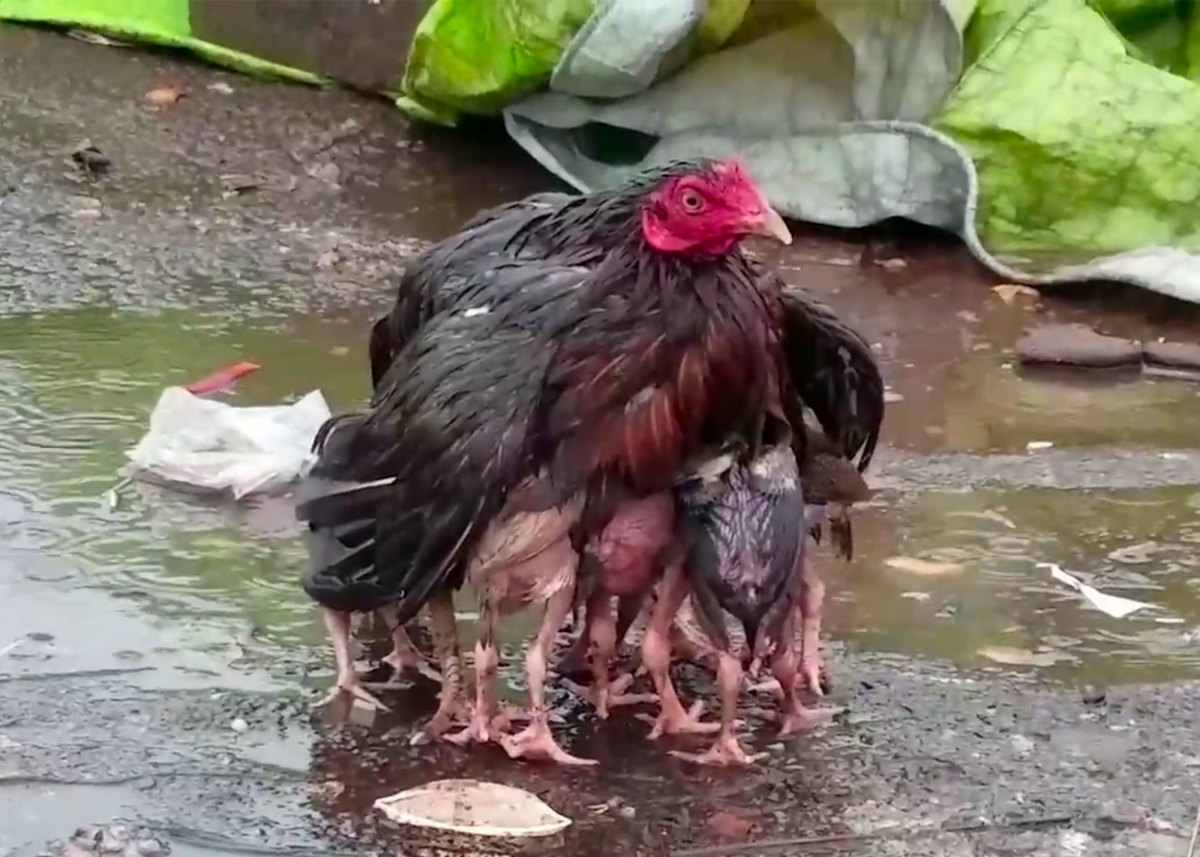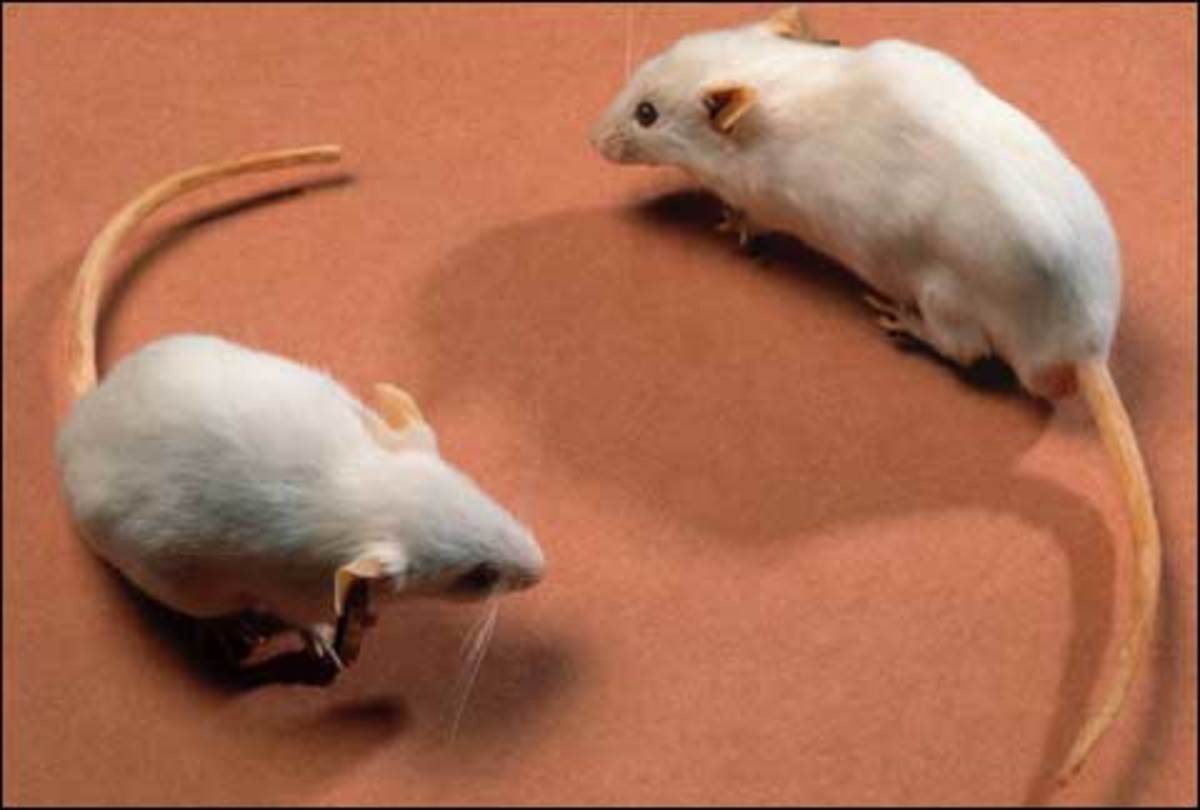Vervet Monkey (Chlorocebus pygerythrus),
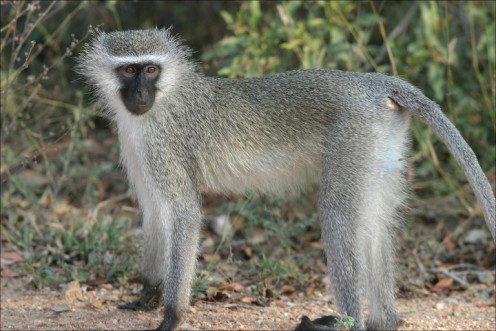
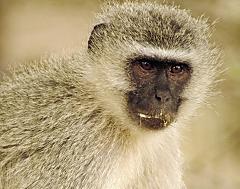

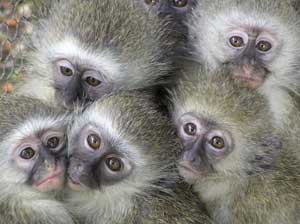



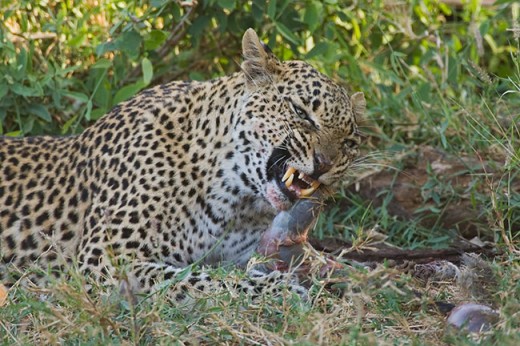
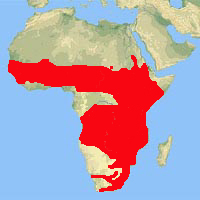

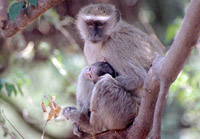
Physical Description:
The Vervet Monkey is usually around 400 to 600 mm in length (head and body); with tales about 300 to 500 mm. weights typically range between 3 and 5 kg. Males are larger than females. All individuals have close-fitting moderate length hairs over most of the body, and elongated side-whiskers. The whiskers are usually a lighter color (white or pale yellow) and differ in length from individual to individual. The faces of Vervet monkeys are usually sooty black. A defining characteristic of this species is the greenish color of the upper parts of the face, which is caused by the banding together of individual hairs with black and yellow strands. In males, the scrotum and perianus are blue in color and the penis has a red color. (Hill, 1965; Parker, 1983)
Habitat:
The Vervet Monkey is an excitable, energetic animal that is commonly found in wooded areas, in both nature reserves and near human settlements. The monkeys are also accidental gardeners.
In East Africa these monkeys can live in mountain areas up to about 13,000 feet, but they do not inhabit rain forests or deserts. Their preferred habitat is acacia woodland along streams, rivers and lakes. They are diurnal, sleeping and eating in trees.
Habits :
Like baboons, they have a highly developed social structure, although their hierarchy is slightly more flexible than that of baboons. Authority is maintained with aggressive threats. They are diurnal and gregarious, living together in troops of 15 - 20 animals.Male Vervets are often larger than females, and unusually for monkeys, there may be several adult males in each troop. These will fight each other for control of the troop, and power frequently changes hands as a dominant male leaves the troop or young males reach maturity.
Vervets scent-mark their territory by running their cheeks or chins on rocks or trees. This releases a strong scent from their facial glands which can be sniffed later by other monkeys. Scent-markings are thought to tell other monkeys about territorial boundaries. The size of a territory will vary depending on the availability of food in the area. Males transfer troops at least once in their lifetime, beginning at puberty. This is a dangerous process not only because of the predators they may encounter in transit, but also because troops dislike immigrants.
Behavior:
Vervet Monkeys have more or less 19 different types of calls. e.g.
Woof-woof: - non-tonal, deep, and has a guttural sound.
Uh: - This call functions as a response to minor predators and is emitted by group members except infants. This call is low-intensity in nature.
Rrr: - This call is emitted by infants and juveniles to communicate distress to their mothers and/or other group members.
Eh, eh: - This call is given by infants and juveniles upon a reunion with their mothers. This call is quiet, short, and non-tonal in nature.
Visual Communication:
Vervet monkeys, like other primates, like to have visual communication and have approximately 8 different types of communicating. e.g.
Staring: - Threat display. The eyes are fixed on the stimulus, the eyebrows are raised and the scalp is retracted, the facial skin is also stretched by moving the ears back.
Head - bobbing: - Threat display.
Penile display: - Demarcate territory; blue testicles indicate dominance, good health and high testosterone levels.
Tail signals: - The position of the tail when an individual is standing on all four limbs will tell the degree of confidence. When fearful, the tail will extend parallel to the ground and as the tail moves up then the individual is more confident.
Diet:
Vervet Monkeys is an omnivorous species that prefers grasses, and also likes to consume the various parts of the acacia tree. For protein the Vervet monkeys eat arthropods and small vertebrates such as lizards and fledgling birds. Vervets have a very mixed diet, although their favorite food is fruit. They will also eat flowers and leaves, crops from farmsteads, and even insects, eggs and small rodents. They collect food using their hands, and the young are taught what foods to pick and how to prepare them for eating by their mothers. Vervets also make regular evening trips to a water-hole to drink. They eat seeds whole, and they pass undigested through them and into their droppings, which are left in ideal places for germination, increasing the abundance of trees.
Breeding:
Sexual maturity: 5 years in the wild, 2 years in captivity.
Gestation: 163 days.
Number of young: 1.
Longevity: 20 years
Vervet monkeys mature slowly, taking around five years to become fertile, although this can vary, depending on the available food supply. In an area where the monkeys are well fed, they can become fertile much sooner. Male monkeys probably will not breed at five years old, because it is unlikely that they will be high enough in the troop's social rankings. Generally, they have to wait for several years before they are senior enough to breed.
A single infant is born five to six months after mating. It is fully furred and its eyes are open, and from birth it is able to cling to its mother's belly fur, though she will usually support it with her arm during the first few hours. The young Vervet suckles less and less as it grows, though it is still nursed by its mother, and is weaned and almost independent in just under a year, before the birth of her next baby.
After a birth, the mother licks the infant clean, bites off the umbilical cord and eats the afterbirth. The newborn has black hair and a pink face; it will be 3 or 4 months before it acquires adult coloration.
Older vervets are allowed to look after the young when they are a few months old. This teaches them how to look after their own young when it is their turn to breed. Females often stay with their mothers for as long as they live, but males leave their family at about five years of age to join other troops.
The females are extremely maternal, and have been known to adopt young from other troops; a bereaved mother will often keep the body of her infant with her for several days.
Young vervets chase one another, wrestle, and tumble and play "king-of-the-castle," taking turns pushing each other off a high perch.
Predators:
Vervets' natural predators include eagles and snakes, particularly the python, which often waits at the bottom of a tree to ambush an unsuspecting monkey as it climbs down. Pythons are able to swallow vervet's whole. Baboons sometimes kill and eat Vervet monkeys too. Vervet monkeys living near areas inhabited by people can become pests, stealing food and other items and raiding crops. This leads to a heavy annual slaughter by poison, traps and guns. In recent years, they have also been considered as a valuable research animal, making live trapping prevalent as well.
Diseases:
They fall prey to skin diseases, caused by parasites. That Vervet monkeys may be carriers of a dangerous zoonotic agent called "Marburg Disease Virus" Marburg Virus Disease is a hemorrhagic fever first described in 1967 when laboratory workers became ill after contacts with vervets imported from Uganda to Marburg (Germany). In 1967 a total 31 persons got infected in Marburg and Frankfurt, and in Belgrade (Serbia). Seven of the patients died.
Myths and believes:
"Fears that Vervets are carriers of rabies or other infectious diseases that can be transmitted to humans are not based on reality.
Vervets are no more likely to transmit such disease than the average household animal, and considering the high incidence of HIV positive humans, people are at far greater risk from fellow humans than from any Vervet or other wild animal.
The major concern about rabies stems from the fact that Vervets aggressively threaten humans or dogs who they believe to be a danger to the troop. People often believe that such an aggressive animal is exhibiting signs of being rabid. This is totally incorrect. As far as can be established, there has never been a confirmed case of rabies in a wild Vervet...
Because Vervets are warm-blooded animals, they can contract rabies if bitten by another infected animal, as can humans and birds. The chances of this are so negligible as to be of virtually no concern to anyone.
In the unlikely event of a person being bitten by a Vervet, they should be treated with the same care that would follow a dog or cat bite, or even a human bite. The circumstances in which such an injury occur should be a deciding factor in determining the nature of the treatment offered."
Dangerous:
Contrary to popular belief, all monkeys do not carry rabies but remember, any animal can be infected with the disease if bitten . . .
Aggression begets aggression . . . every cornered animal is dangerous. Instinctively, flight is preferred to fight but it is also instinctive for an animal to protect his own. During breeding season when mothers are carrying their young babies, the monkeys will be a lot more nervous than normal and aggression can be invoked far more quickly. Who would want it any other way!
Remember that in the animal world, sudden movement indicates attack, a show of teeth is a sign of aggression, and direct eye contact is a challenge - be aware of your own body language when approaching any wild animal!
If you do come across an injured animal;
Remember it's traumatized and will behave accordingly
approach the animal calmly and quietly
call for rescue assistance if it is still mobile or retrieval is awkward
keep the animal warm until medical assistance is available
Distribution:
Vervet Monkeys are found throughout Southern, Eastern and Western Africa.
Sanctuaries:
Kruger National Park (South Africa)
Pilanesberg National Park (South Africa)
http://www.monkeyland.co.za/relatedlinks.htm
References:
Harris, R. S. 1970. Feeding and Nutrition of nonhuman Primates. Academic Press, New York
Hill. 1965 Primates, Comparative Anatomy and Taxonomy. Volume VI. University Press, Edinburgh
- Monkeyland South-Africa
Primate Sanctuary


